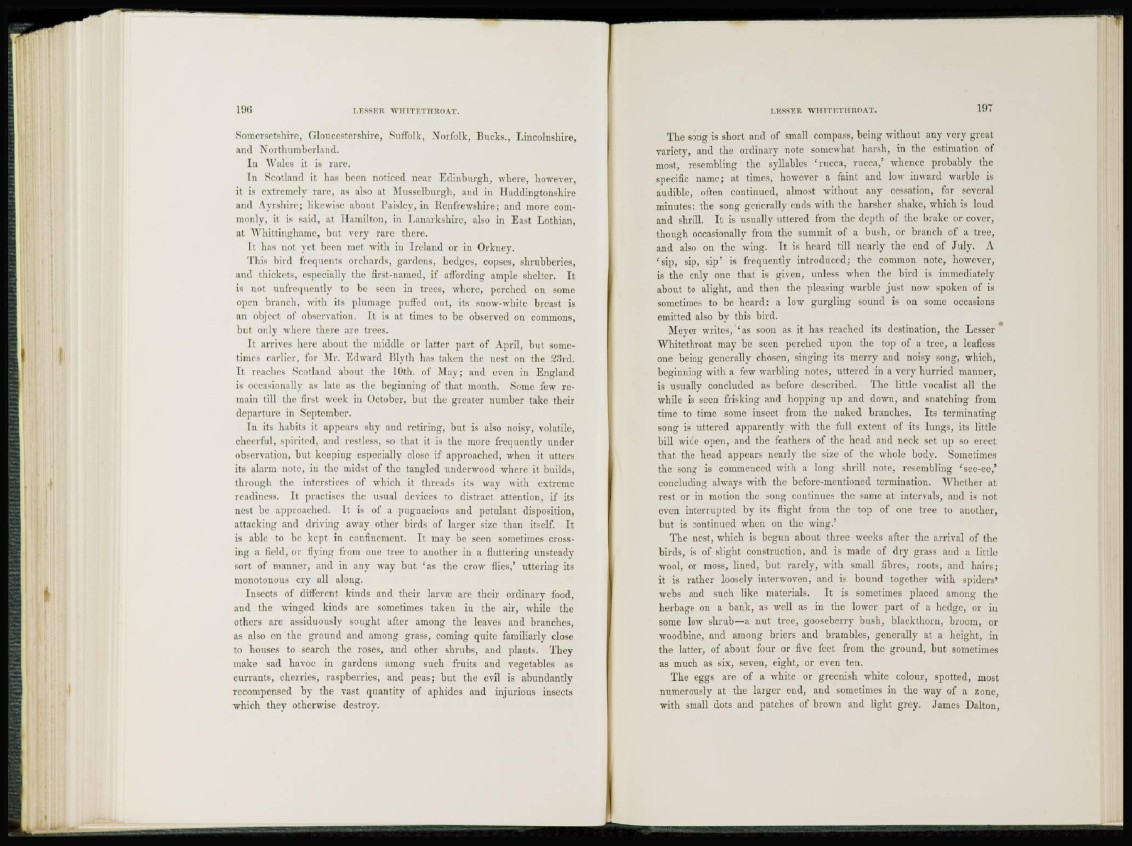
196 LESSER WTITTETTIROAT.
Somersetshire, Gloucestershire, Suffolk, Norfolk, Bucks., Lincolnshire,
and Northumberland.
I n Wale* it is rare.
In Scotland it has been noticed near Edinburgh, where, however,
it is extremely rare, as also at Musselburgh, and in Haddingtonshire
and Ayrshire; likewise about Paisley, in Renfrewshire; and more commonlv,
it is said, at Hamilton, in Lanarkshire, also in East Lothian,
at Whittinghamc, but very rare there.
It has not yet been met with in Ireland or in Orkney.
This bird frequents orchards, gardens, hedges, copses, shrubberies,
and thickets, especially the first-named, if affording ample shelter. It
is not (infrequently to be seen in trees, where, perched on some
open branch, with its plumage puffed out, its snow-white breast is
an object of observation. It is at times to be observed on commons,
bul only where there are trees.
It arrives here about the middle or latter part of April, but sometimes
earlier, for Mr. Edward Blyth has taken the nest on the 23rd.
I t reaches Scotland about the 10th. of May; and even in England
is occasionally as late as the beginning of that month. Some few remain
till the first wick in October, but the greater number take their
departure in September.
In its habits it appears shy and retiring, but is also noisy, volatile,
cheerful, spirited, and restless, so that it is the more frequently under
observation, but keeping especially close if approached, when it utters
its alarm note, in the midst of the tangled underwood where it builds,
through the interstices of which it threads its way with extreme
readiness. It practises the usual devices to distract attention, if its
nest be approached. It is of a pugnacious and petulant disposition,
attacking and driving away other birds of larger size than itself. It
is able to be kept in confinement. It may be seen sometimes crossing
a field, or flying from one tree to another in a fluttering unsteady
sort of manner, and in any way but *as the crow Hies,' uttering its
monotonous cry all along.
Insects of different kinds and their larva; are their ordinary food,
and the winged kinds are sometimes taken in the air, while the
others are assiduously sought after among the leaves and branches,
as also en the ground and among grass, coming quite familiarly close
to houses to search the roses, and other shrubs, and plants. They
make sad havoc in gardens among such fruits and vegetables as
currants, cherries, raspberries, and peas; but the evil is abundantly
recompensed by the vast quantity of aphides and injurious insects
which they otherwise destroy.
LESSER WHTTETHROAT. 197
The song is short and of small compass, being without any very great
variety, and the ordinary note somewhat harsh, in the estimation of
most, resembling the syllables 'rucca, rucca,' whence probably the
specific name; at times, however a faint and low inward warble is
audible, often continued, almost without any cessation, for several
minutes: the song generally ends with the harsher shake, which is loud
and shrill. It is usually uttered from the depth of the brake or cover,
though occasionally from the summit of a bush, or branch of a tree,
and also on the wing. It is heard till nearly the end of July. A
( s i p , sip, sip' is frequently introduced; the common note, however,
is the only one that is given, unless when the bird is immediately
about to alight, and then the pleasing warble just now spoken of is
sometimes to be heard: a low gurgling sound is on some occasions
emitted also by this bird.
Meyer writes, {as soon as it has reached its destination, the Lesser
Whitethroat may be seen perched upon the top of a tree, a leafless
one being generally chosen, singing its merry and noisy song, which,
beginning with a few warbling notes, uttered in a very hurried MARINER,
is usually concluded as before described. The little vocalist all the
while is seen frisking and hopping up and down, and snatching from
time to time some insect from the naked branches. Its terminating
song is uttered apparently with the full extent of its lungs, its little
bill wide open, and the feathers of the head and neck set up so erect
that the head appears nearly the size of the whole body. Sometimes
the song is commenced with a long shrill note, resembling esce-ce,'
concluding always with the before-mentioned termination. Whether at
rest or in motion the song continues the same at intervals, and is not
even interrupted by its flight from the top of one tree to another,
but is continued when on the wing.'
The nest, which is begun about three weeks after the arrival of the
birds, is of slight construction, and is made of dry grass and a little
wool, or moss, lined, but rarely, with small fibres, roots, and hairs;
it is rather loosely interwoven, and is bound together with spiders'
webs and such like materials. It is sometimes placed among the
herbage on a bank, as well as in the lower part of a hedge, or in
some low shrub—a nut tree, gooseberry bush, blackthorn, broom, or
woodbine, and among briers and brambles, generally at a height, in
the latter, of about four or five feet from the ground, but sometimes
as much as six, seven, eight, or even ten.
The eggs are of a white or greenish white colour, spotted, most
numerously at the larger end, and sometimes in the way of a zone,
with small dots and patches of brown and light grey. James Dalton,